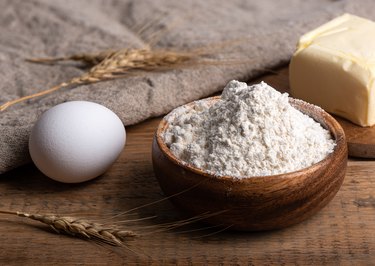
It's natural to assume that because self-rising flour eliminates the need for leavening agents in your baked goods that it is a better choice than all-purpose flour for baking. In some cases, this is true and self-rising flour is a convenient alternative to regular flour, but that is not always the case. Because self-rising flour contains added leavening agents using it incorrectly can throw off the texture and flavor of your baked goods.
Self-Rising Flour
Video of the Day
Self-rising flour typically contains added baking powder and salt to act as leavening agents. In recipes that call for self-rising flour, the dough relies on the leavening agents in the flour to cause the dough or batter to rise. The addition of water and exposure to heat activate the baking powder, causing it to give off gas bubbles that cause your baked goods to rise. It contains approximately 1 1/2 teaspoons of baking powder per cup of flour and may contain added salt.
Video of the Day
Understanding Leavening Agents
Leavening agents are responsible for causing baked goods to rise. Some recipes call for baking soda and an acidic ingredient, such as sour cream, buttermilk or citrus juice. Exposing baking soda and the acidic ingredients to liquids and heat creates a chemical reaction that releases carbon dioxide gas. The carbon dioxide gas forms the bubbles in the batter that make it rise. Other recipes call for baking powder. Baking powder already contains both baking soda and acidic salts. These react in the same way as baking soda and acids to cause your baked goods to rise. Sometimes, recipes with acidic ingredients call for both baking powder and baking soda. Some recipes, such a breads and rolls, rely on yeast as leavening.
Substituting Self-Rising Flour
To substitute self-rising flour for all-purpose flour, omit the baking powder and reduce the amount of salt in the original recipe. This works well for quick breads, biscuits and recipes that do not contain added baking soda or acidic ingredients. Because of the delicate interplay between acidic ingredients and baking soda (an active ingredient in baking powder), using self-rising flour instead of all-purpose flour in recipes that also include baking soda and acidic ingredients may be risky as it may offset the balance needed for proper rising. Self-rising flour should not be substituted for recipes containing yeast as it does not work in the same way and will not produce the same results.
Trial and Error
Substituting self-rising flour for all-purpose flour may require some trial and error to determine the correct amount of baking powder and salt, particularly if your recipe also contains baking soda or acidic ingredients. Likewise, using all-purpose flour in recipes that call for self-rising flour may require adjustments, namely adding 1 1/2 teaspoons of baking powder per cup of flour. Tweaking the amount of baking soda and salt in the recipes may be necessary to get the flavor and texture you desire in your baked goods.